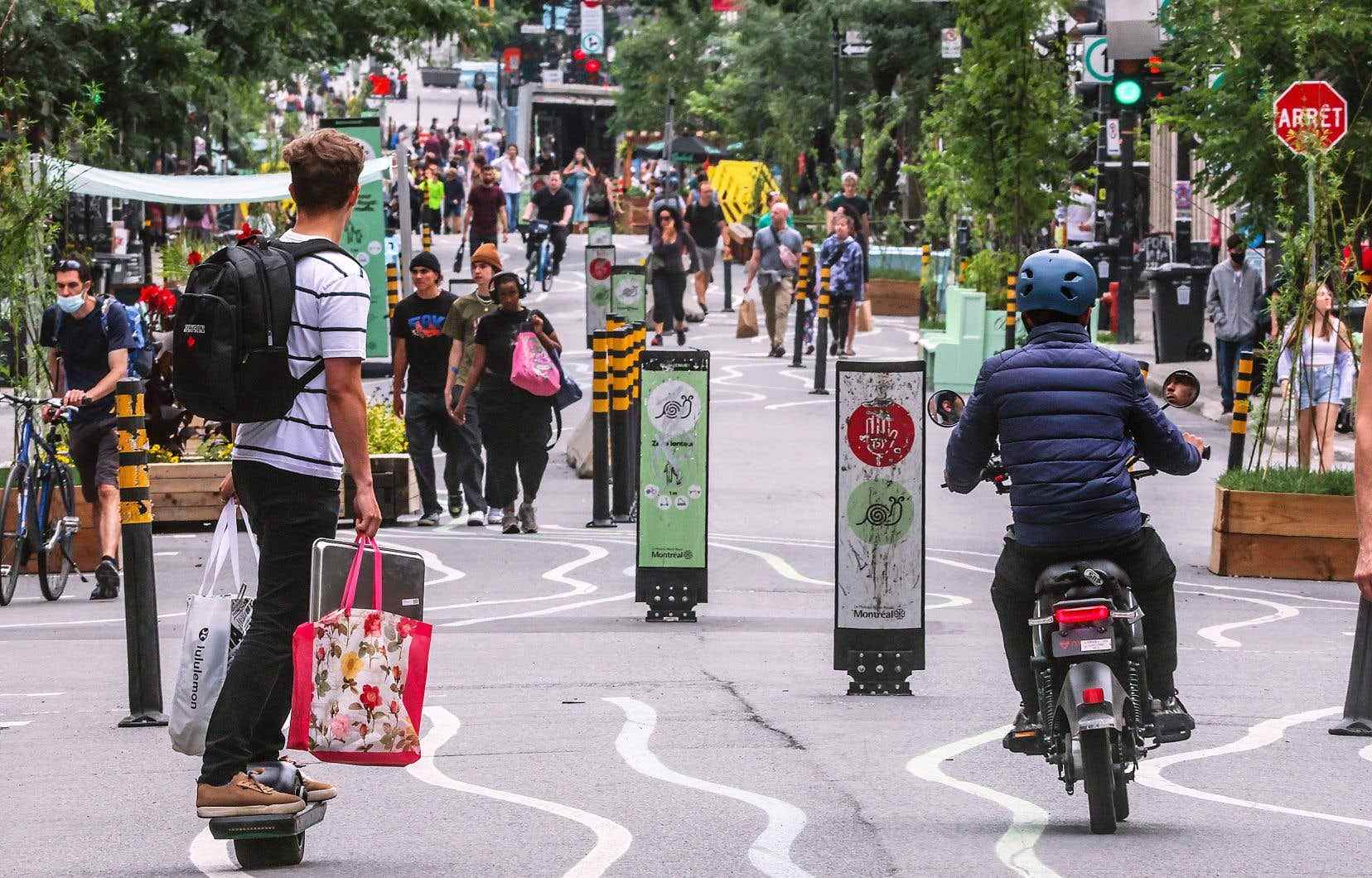The cohabitation between pedestrians and cyclists is not always harmonious in the pedestrian arteries in Montreal. But the presence of scooters and other small electric vehicles is deemed particularly problematic this year, so much so that several business development companies (SDCs) would like to see them stay out of their pedestrian thoroughfares.
In 2021, the SDCs of avenue du Mont-Royal and promenade Wellington had decided to authorize the circulation of bicycles in pedestrianized arteries. And to calm the enthusiasm of some speed enthusiasts, a “slow zone” had been decreed.
Some bicycle offenders continue to sprint there on occasion, and many pedestrians are complaining about it on social media. But the problem that most concerns the SDC on Mont-Royal Avenue this year is the presence of mopeds, scooters and electric boards. Even electrically assisted bicycles are sometimes a problem, says SDC general manager Claude Rainville. “Mopeds and scooters have no business on a pedestrian street. In my opinion, this needs to be reviewed,” he said.
No accident has been reported on Mont-Royal Avenue, but Mr. Rainville’s observations on the ground lead him to say that solutions must be discussed with the borough. He also points the finger at delivery people from companies like Uber Eats and DoorDash who, on bicycles or scooters, do not pay too much attention to the rules of good citizenship, he says.
The CEO of the Wellington Promenade SDC, Patrick Mainville, also believes that scooters have no place in pedestrian streets. “I don’t understand what can go through someone’s mind when they decide to drive down Wellington Street and risk injuring a child. Is beyond me. »
A legislative vagueness
Prohibiting electric-powered vehicles in pedestrian arteries is not so simple, because they are not currently regulated, points out Sandrine Cabana-Degani, general manager of Piétons Québec.
A working committee on micromobility has been set up by the Ministère des Transports du Québec to better regulate these modes of transport and integrate them into the Highway Safety Code, but the results of this work are still pending, she says. . An update to the Code would define each type of vehicle and determine where they are allowed to travel and at what speed, says Ms.me Cabana Degani. “At the moment, the vagueness maintained around these vehicles makes cohabitation difficult. »
But that’s not all. The status of the pedestrian streets is slow to be clarified. “The pedestrian street does not exist in the Highway Safety Code. When a city closes a street, it becomes a “public place”. It is no longer a public road. So it is no longer regulated by the Highway Safety Code. This makes it difficult for the police to intervene regarding traffic rules, ”explains the leader of Piétons Québec.
“If we want pedestrian streets to be permanent and to increase in number in Montreal and elsewhere in Quebec, we must oversee and regulate the way in which cohabitation must take place. »
The coexistence of pedestrians and cyclists
Although the presence of cyclists exasperates many pedestrians, cohabitation with them is not as conflicting as one might think, concluded researchers from the National Institute for Scientific Research (INRS) and Polytechnique Montreal. Last summer, they conducted observations on certain sections of Mont-Royal Avenue, Wellington Street and Bernard Street, in addition to analyzing video images of pedestrian and cyclist movements.
“The conclusion is that the cohabitation is going rather well. According to the data collected, there have not been many very problematic cases of dangerous interactions between pedestrians and cyclists,” explains Marie-Soleil Cloutier, professor at INRS. “Observations show that barely 30% of cyclists were too close to pedestrians — less than two meters. And when a cyclist was close to the pedestrian, most of the time it was the cyclist who changed his trajectory. »
“Obviously, a bike that goes too fast, it strikes the imagination,” she continues. “Obviously, it’s him that we remember, and not the 14 cyclists who passed before, but who did it like people. »
Last year, Promenade Ontario had banned the presence of bicycles in the pedestrian artery, but according to the CEO of the SDC of Hochelaga-Maisonneuve, Patrick Legault, cyclists who ventured there tended to ride there quickly. , for fear of being intercepted. The SDC finally authorized their presence this year. “The situation remains problematic, but it is much better controlled,” says Mr. Legault. “Most cyclists are careful. The concept of “slow zone” is more efficient and safer, I find. »
According to the CEO of Vélo Québec, Jean-François Rheault, cyclists must behave “exemplarily”.
“For us, it’s clear that on pedestrian streets, cyclists are guests. It’s a privilege to be here, and it comes with responsibilities. And these responsibilities are that at no time [les cyclistes] surprise pedestrians or frighten them. »
